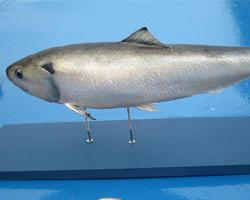
Váhy a míry
| Hmotnost | 2,7 kg |
|---|
Popis zvířete
The Allis shad (Alosa alosa) is a fascinating species of fish that belongs to the herring family, Clupeidae. This intriguing fish is known for its unique characteristics and behaviors that distinguish it from other members of its family. The Allis shad is primarily found in the temperate and coastal waters of the northeastern Atlantic Ocean, ranging from the coasts of Norway to as far south as the Iberian Peninsula. It is also present in the Mediterranean and the Black Sea, showcasing its adaptability to different marine environments.Physically, the Allis shad is a sleek and streamlined fish, capable of reaching up to 75 cm in length, though sizes around 40 to 60 cm are more common. It boasts a relatively high and laterally compressed body, which aids in its efficient swimming. The fish is easily identifiable by its silvery-blue color on the dorsal side, which gradually transitions to a gleaming silver on the flanks and belly. This coloration not only makes the Allis shad a beautiful sight but also serves as a form of camouflage against predators when viewed from different angles. The species has a distinctive dark spot located behind the gill cover, and often, several more spots can be found running along its flanks.
The Allis shad's diet primarily consists of small fish and plankton, which it filters from the water using its well-developed gill rakers. This feeding habit places the Allis shad as an important link within the aquatic food web, contributing to the balance of marine ecosystems.
One of the most remarkable aspects of the Allis shad's life cycle is its spawning behavior. The species is anadromous, meaning it spends the majority of its life in the sea but returns to fresh water to spawn. This journey is undertaken by mature individuals, usually between the ages of four to seven years, during the spring months. The Allis shad's preferred spawning grounds are often located in large rivers, where the water is clear and the current is strong. Here, females can lay up to 140,000 eggs, which are then fertilized by the males. After spawning, many individuals perish, a phenomenon common among anadromous fish.
The Allis shad faces several threats that have led to a decline in its population in recent years. Overfishing, habitat destruction, and pollution are the primary concerns. Additionally, the construction of barriers such as dams on rivers obstructs their migration paths to spawning grounds, significantly impacting their reproduction rates. Conservation efforts are underway in various parts of their range to address these challenges, including habitat restoration, the implementation of fishing quotas, and the construction of fish passages around barriers.
In conclusion, the Allis shad (Alosa alosa) is a species of great ecological importance and fascinating biological characteristics. Despite facing significant challenges, efforts to conserve and protect this species are crucial for maintaining the biodiversity and health of marine and freshwater ecosystems where it plays a critical role.
Nové fotografie zvířat
Top 10 zvířat
- Chinese water dragon (Physignathus cocincinus)
- Galápagos tortoise (Geochelone nigra complex)
- Dolphin gull (Leucophaeus scoresbii)
- Japanese macaque (Macaca fuscata)
- Colombian red howler (Alouatta seniculus)
- Sea urchins (Echinoidea)
- Moustached guenon (Cercopithecus cephus)
- Diana monkey (Cercopithecus diana)
- Common reed warbler (Acrocephalus scirpaceus)
- Common house mosquito (Culex pipiens)